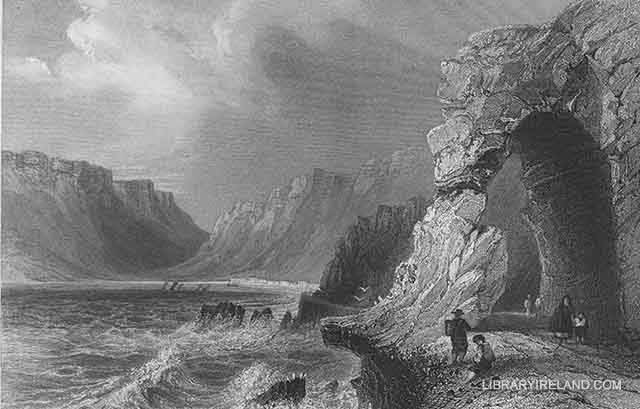Glenariff, County Antrim
With an easy car, a smart little Shetland mare, a silent, but good-natured driver, and a bright sun, it would have been difficult not to have enjoyed our drive from Glenarm to Cushendall. We crossed the outlets of several deep and romantic glens, and observed that there was not one without its waterfall. Over one or two, at the brow of the precipice from which the white torrent took its first leap, we noticed light bridges, and plantations in their neighbourhood, indicating park-scenery on the table-land above. We soon entered upon the curve of the Red Bay, and crossed the entrance of the wild VALE OF GLENARIFF, "called sometimes Glen-aireamp, the Valley of Numbers, and Glen-aireachaib, the Valley of Chiefs." Up this glen is a waterfall with the musical name of Isnaleara, which, sends its waters to the sea near the caves of Red Bay. The prospect to the west is terminated by the lofty conical summit of Cruach-a-crue, while that to the north is limited by the extraordinary mountain of Lurgeidan, not unlike the frustum of an enormous cone of considerable altitude, but whose base is disproportionately narrow.
Passing the neglected hamlet of Waterford, at the mouth of the Glenariff river, the caves of Red Bay are reached: they are excavations, probably formed at some remote period by the inroads of the tide (which is now excluded by the embankment in front), in a species of soft red sandstone. There are three of tolerable magnitude; one of which is very appropriately converted into a smith's forge, and affords a most Cyclopean appearance. A second is reported to be the residence of a female (Nancy Murray, the driver called her) whose trade is the sale of illicit spirits. The ruined castle of Red Bay towered above us as we passed from a lofty arch cut through the southern extremity of one of the red cliffs, and beneath this is a cave, said once to have been used as a school. The castle was built, it is supposed, by the Bissetts, from whom the Antrim family derive this barony.

